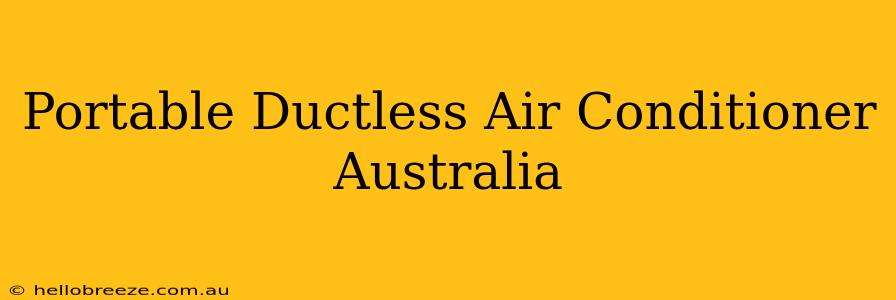Summer in Australia can be brutal. Staying cool and comfortable in your home or office shouldn't break the bank or require major renovations. That's where portable ductless air conditioners come in. These units offer a convenient and effective cooling solution without the hassle of complicated installations. This comprehensive guide will help you navigate the world of portable ductless air conditioners in Australia.
What are Portable Ductless Air Conditioners?
Portable ductless air conditioners, also known as portable split system air conditioners, offer a compelling alternative to traditional window units or expensive ducted systems. They consist of two main parts: an indoor unit that cools your space and an outdoor unit that houses the condenser. Unlike window units, the indoor unit is portable and can be moved from room to room as needed. The units are connected by a refrigerant line, which is usually relatively easy to install and manage. This flexibility makes them ideal for renters, those living in apartments, or anyone who wants to target cooling to specific areas of their home.
Key Advantages of Portable Ductless Air Conditioners in Australia:
- Portability: Easily move the indoor unit to any room requiring cooling.
- Flexibility: Ideal for renters or those who want to avoid permanent installations.
- Targeted Cooling: Cool only the spaces you need, saving energy and money.
- Energy Efficiency: Modern models offer improved energy efficiency ratings.
- Improved Comfort: Enjoy precise temperature control and consistent cooling.
- No Ductwork Required: Avoid the expense and disruption of installing ductwork.
Choosing the Right Portable Ductless Air Conditioner for Your Needs
Selecting the right air conditioner depends on several factors:
1. Room Size:
The most crucial factor is the size of the room you intend to cool. Air conditioners are rated in BTUs (British Thermal Units) or kilowatts (kW), indicating their cooling capacity. Underestimating the required BTU/kW can lead to insufficient cooling, while overestimating can be wasteful and expensive. Consult the manufacturer's specifications or seek expert advice to determine the appropriate size for your space.
2. Energy Efficiency:
Look for units with high energy efficiency ratings, such as a high Energy Star rating. This will help you save money on your electricity bills in the long run. Pay attention to the Energy Efficiency Ratio (EER) or Seasonal Energy Efficiency Ratio (SEER) rating. Higher ratings indicate greater efficiency.
3. Features and Functionality:
Consider features such as:
- Remote Control: For convenient operation from anywhere in the room.
- Multiple Cooling Modes: Different modes allow for more precise temperature control and comfort.
- Timer: Schedule the unit to turn on and off automatically.
- Dehumidification: Helps control humidity levels in addition to cooling.
- Sleep Mode: Reduces noise and energy consumption during sleep.
- Noise Level: Look for models with quieter operation for a more peaceful environment.
4. Installation:
While installation is generally straightforward, ensure you have appropriate access for the outdoor unit and understand the hose setup process connecting the indoor and outdoor units. Consider professional installation for peace of mind.
Maintaining Your Portable Ductless Air Conditioner
Regular maintenance extends the life of your air conditioner and ensures optimal performance. This includes:
- Cleaning the filters: Regularly clean or replace air filters to maintain optimal airflow and efficiency.
- Inspecting the coils: Check the coils for any debris or dirt buildup.
- Professional servicing: Consider annual professional servicing for thorough inspection and maintenance.
Conclusion
Portable ductless air conditioners offer a convenient and effective cooling solution for Australian homes and offices. By considering factors like room size, energy efficiency, and desired features, you can choose the perfect unit to beat the heat and enjoy comfortable living throughout the summer months. Remember to research different brands and models to find the best fit for your specific needs and budget. Remember to always consult the manufacturer’s guidelines and seek professional advice when needed, especially concerning installation and maintenance.

